One of the most important KPI is the LTE Call Drop Rate. Every network is striving to improve this KPI and it has become more important in LTE since the introduction of VoLTE. In simple words, a call drop in LTE means that a user’s ongoing session is dropped requiring the user to initiate a new connection to resume services. At the eNB level, this can be seen as an abnormal release which is verified from the cause code inside the Context Release message.
Common Causes for Call Drops
Like other KPIs, the call drop is also divided into two broad categories
- Radio Induced Drops
- MME Induced Drops
LTE KPI Optimization: LTE Call Drop Rate
1. Radio Induced Call Drops
Ø DL RLC Retransmissions
The most common drop pegged under Radio issues is the drop due to RLC retransmissions. If a network has a maximum of 16 RLC retransmissions for downlink, the eNB will send a message 16 times at the RLC layer and if the UE is unable to decode it or send an acknowledgement, the eNB will consider this a RLF. Some vendors initiate a UE Context Release at this point resulting in an abnormal release and a call drop. Some vendors wait for a bit longer (an internal timer) for the UE to initiate RRC ReEstablishment and if there is no RRC ReEstablishment then the eNB will release abnormally and radio induced call drop will be pegged.
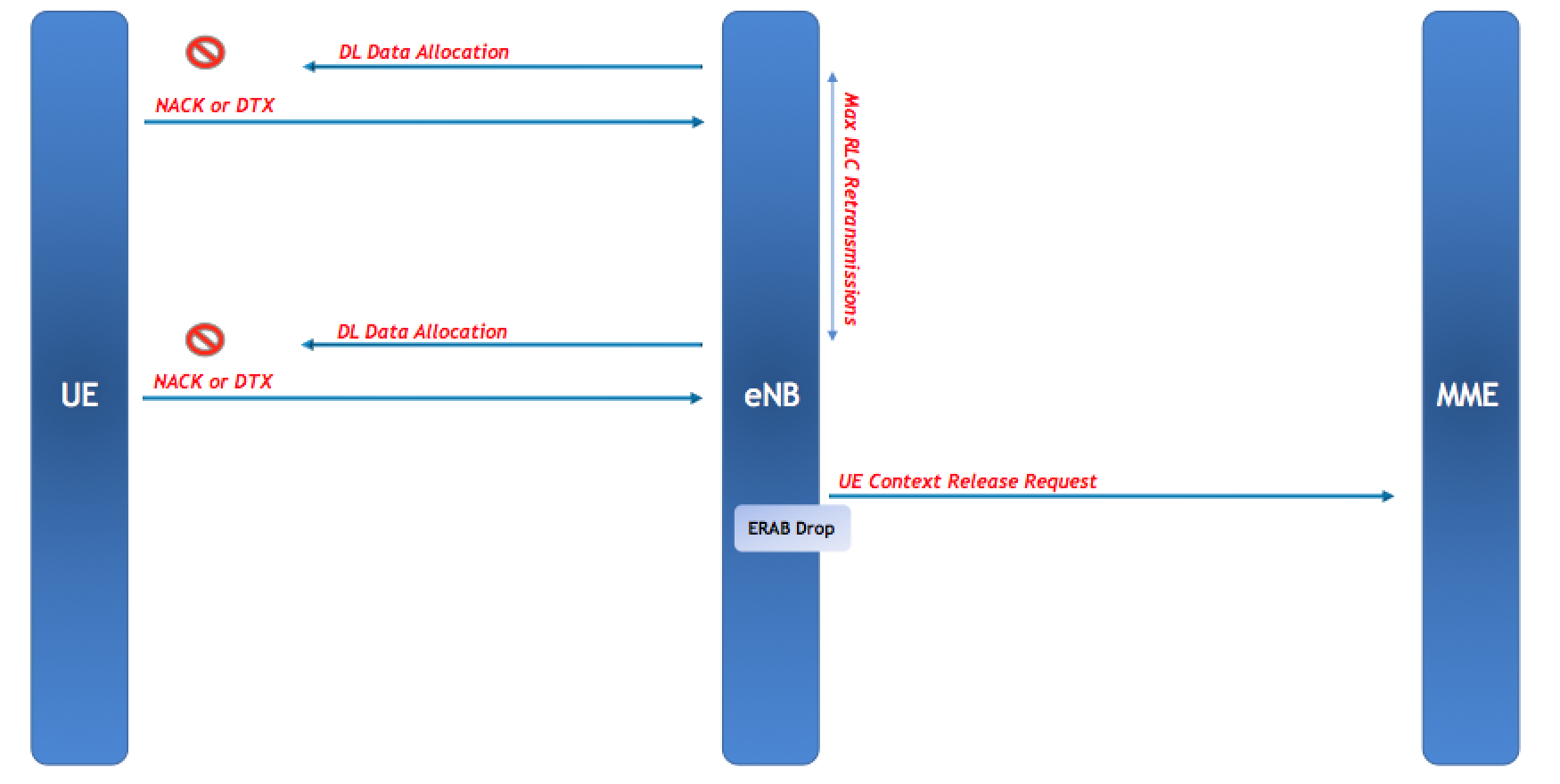
The difference between the DL and UL RLC Retransmissions is that in case of DL retransmissions, the eNB knows that the UE has lost the radio connection, so it can release the resources and peg a radio induced call drop. But in case of UL RLC retransmissions, the eNB usually does not know that the UE has reached RLF conditions and will only find this out when the UE sends a RRC ReEstablishment Request.
- Optimization
This issue is mostly due to coverage and quality problems. So, the best way to sort this out is to improve radio conditions which is usually done with physical optimization. Increasing RLC retransmission threshold to a higher value might also help in reducing this issue.
Ø Handover Execution Failure
Consider a scenario, where UE tries to perform a handover and fails. In this case, the UE will wait for a specific time as per T304 and once T304 expires, it will initiate a RRC ReEstablishment with the cause value of Handover failure. Now, if this RRC ReEstablishment also fails and the UE is unable to get a connection, the source eNB will release the context after expiry of the internal timer. This is the X2 Reloc Overall Timer and the cause of this release will be X2 Reloc Overall Expiry. Such a case is pegged under call drop due to Handover failure.
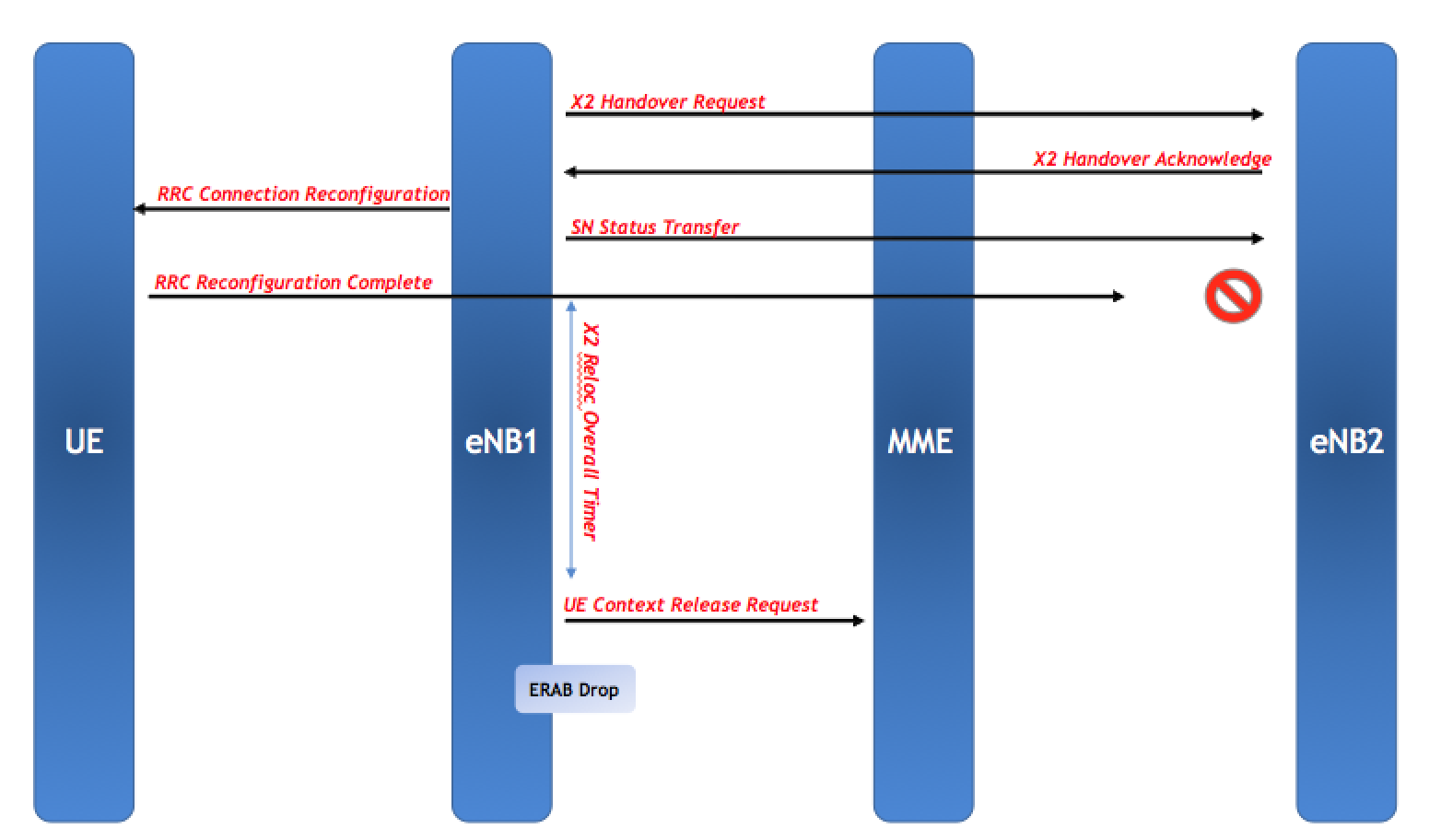
- Optimization
The most common issue for this kind of failure is when the target cell is very far away such that when the UE initiates handover on the target cell, it is at a distance beyond the cell radius. So, the target cell fails to decode the dedicated RACH properly for this UE and it results in a handover failure. So, in this case, either increase the cell radius of the target cell or downtilt it so that it does not overshoot beyond its planned radius. This can also happen in areas where there are large water bodies as signals easily tend to get reflected over water. In such cases, either forbid handovers to such cells or add offsets for those cells to make handovers difficult.
Ø Drop Due to No Response
If an eNB sends a signalling message for instance RRC Reconfiguration then it expects a response from the UE. If the UE does not send a RRC Reconfiguration Complete message to the eNB and the internal timer on the eNB expires, then the eNB initiates a release. This timer is usually a large value, so such a drop is rare. If such drops are seen then verify that the eNB’s internal timer is not set to a very small value.
Point to note is that RRC Reconfiguration for mobility command is excluded from this mechanism as the UE needs to send its response to the target cell and not to the source cell.
Ø Other Optimization Work-Arounds
The value of UE Inactivity timer also plays an important part in the calculation of Call Drop Rate. The expiry of this timer means that the UE has been inactive for some time and the eNB releases it. The UE goes to idle mode and the eNB pegs a normal release. The Call Drop Rate is ratio of total abnormal releases to the total releases. So, if the UE Inactivity timer is a small value, there will be a greater number of normal releases which can artificially reduce the CDR. In short, while benchmarking two different networks, it is important to verify that they have the same UE Inactivity Timer value so that they can be compared properly.
However, reducing the inactivity timer can cause an increase in RRC signalling so it should not be reduced excessively.
2. MME Induced Drops
The MME drops are usually caused by radio issues but they are pegged under MME drops because the eNB has no way of knowing that the drop was caused by a radio issue. Lets understand with help of different cases that are pegged under MME induced drops.
Ø Uplink RLC Retransmission Issue
Consider a UE that experienced RLF due to maximum number of uplink RLC retransmission. Such a UE will initiate a RRC ReEstablishment procedure to regain its radio link. Now this RRC ReEstablishment can be to the serving cell and in that case, it is usually successful since the serving cell already has the UE’s context. However, this RRC ReEstablishment can also be sent to another cell from eNB2 that does not belong to the source eNB (eNB1). In this case, if eNB2 is a neighbor of the eNB1 so it will try to fetch the context for this UE from eNB1 and based on that it will accept the RRC ReEstablishment. However, if the eNB2 is not a neighbor then it will reject the RRC ReEstablishment. From the UE’s perspective this will be considered a call drop but at the eNB1, the eNB still does not know that this UE has experienced RLF. Now, the UE will initiate a new RRC Connection at the eNB2 and based on that the eNB2 will forward S1 Initial UE Message to the MME. MME will check the UE and it will find out that this UE’s context already exists on the eNB1 so it will send a UE Context Release to the eNB1 and then it will send S1 Initial Context Setup Request to the eNB2. The eNB1 will consider this a MME induced drop since the eNB1 still holds the UE’s context and a release from MME is considered abnormal. However, in reality, such a release is caused by a failure over the radio interface but the eNB1 does not have this knowledge.
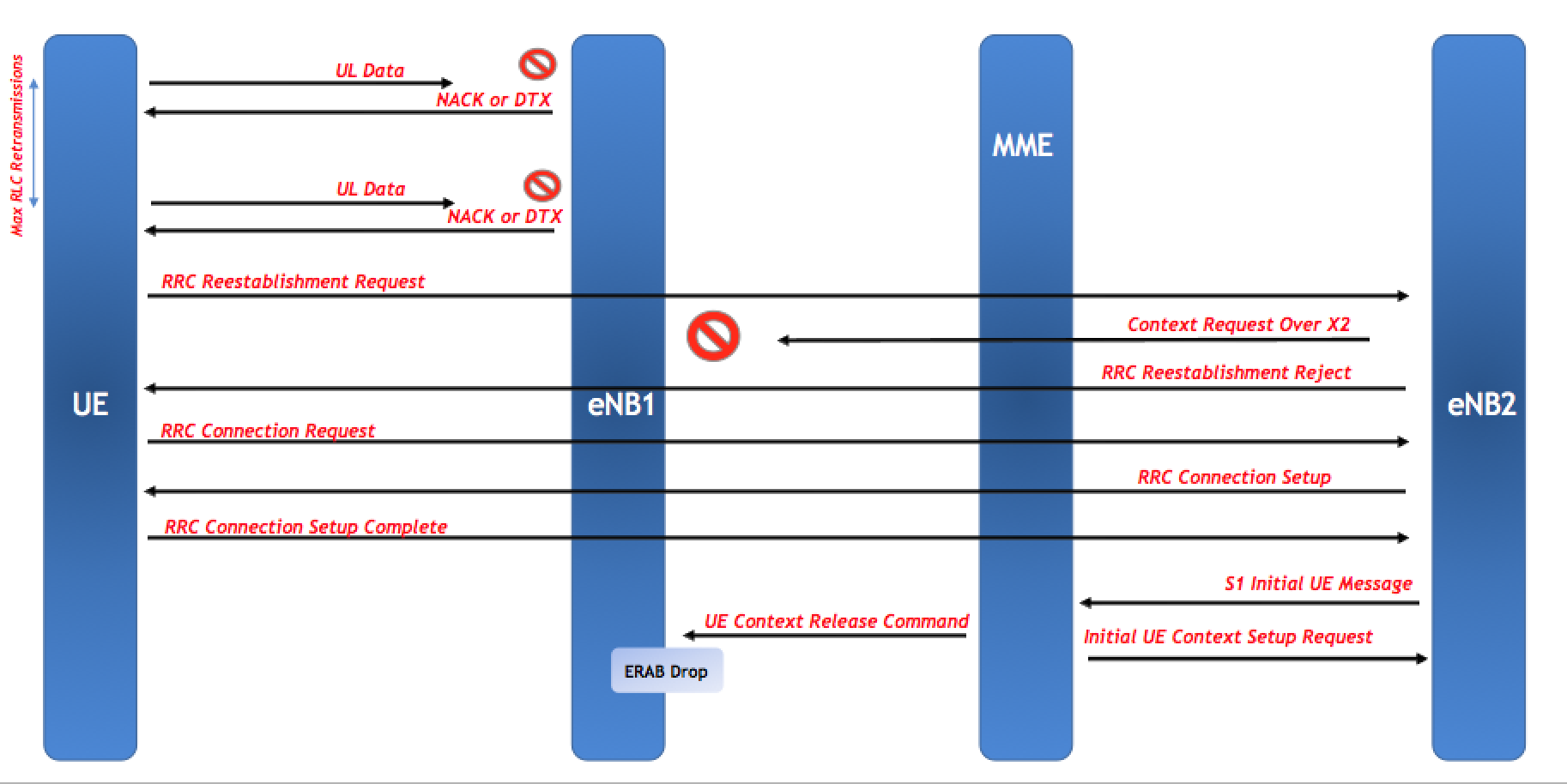
- Optimization
Increasing the uplink RLC retransmission threshold can help reduce such failures. For instance, if the RLC retransmission count threshold is increased from 8 to 16, then the RLC will retransmit 16 times instead of 8 times which will increase the probability that the eNB might be able to decode the message and prevent RLF.
Ø N310 PDCCH Decoding Failures
If the UE is unable to decode PDCCH in DL for N310 consecutive intervals, the UE will initiate a RRC ReEstablishment. N310 indicates an interval of 200 PDCCH decoding failures. Simply put, if the UE fails to decode PDCCH for 200ms, it will be considered one N310. However, from here onwards, it is a sliding window with 10ms granularity. So, if the N310 value is 2 then it means that if the UE fails to decode PDCCH for 210 ms, it will have exceeded the configured N310 threshold. Once, N310 has been exceeded, the UE starts timer T310 and if the UE is unable to retain the connection (still unable to decode PDCCH) before T310 expires, the UE will initiate RRC ReEstablishment. Let’s understand with an example. Consider N310 of 11 and T310 of 500ms, then the UE will initiate RRC Connection ReEstablishment after 800 ms (N310 = (200 + (10*10)) = 300ms + T310 = 500ms).
Again, in this case, if the UE receives a RRC ReEstablishment Rejection from the eNB2, then the UE will initiate a new RRC Connection. Once the RRC Connection is setup, the eNB2 will send a S1 Initial UE Message to the MME and consequently, MME will send a UE Context Release Command to the eNB1 since MME already has the context of this UE against eNB1 and in order to process Initial Context Setup on eNB2, it has to release the context on eNB1.
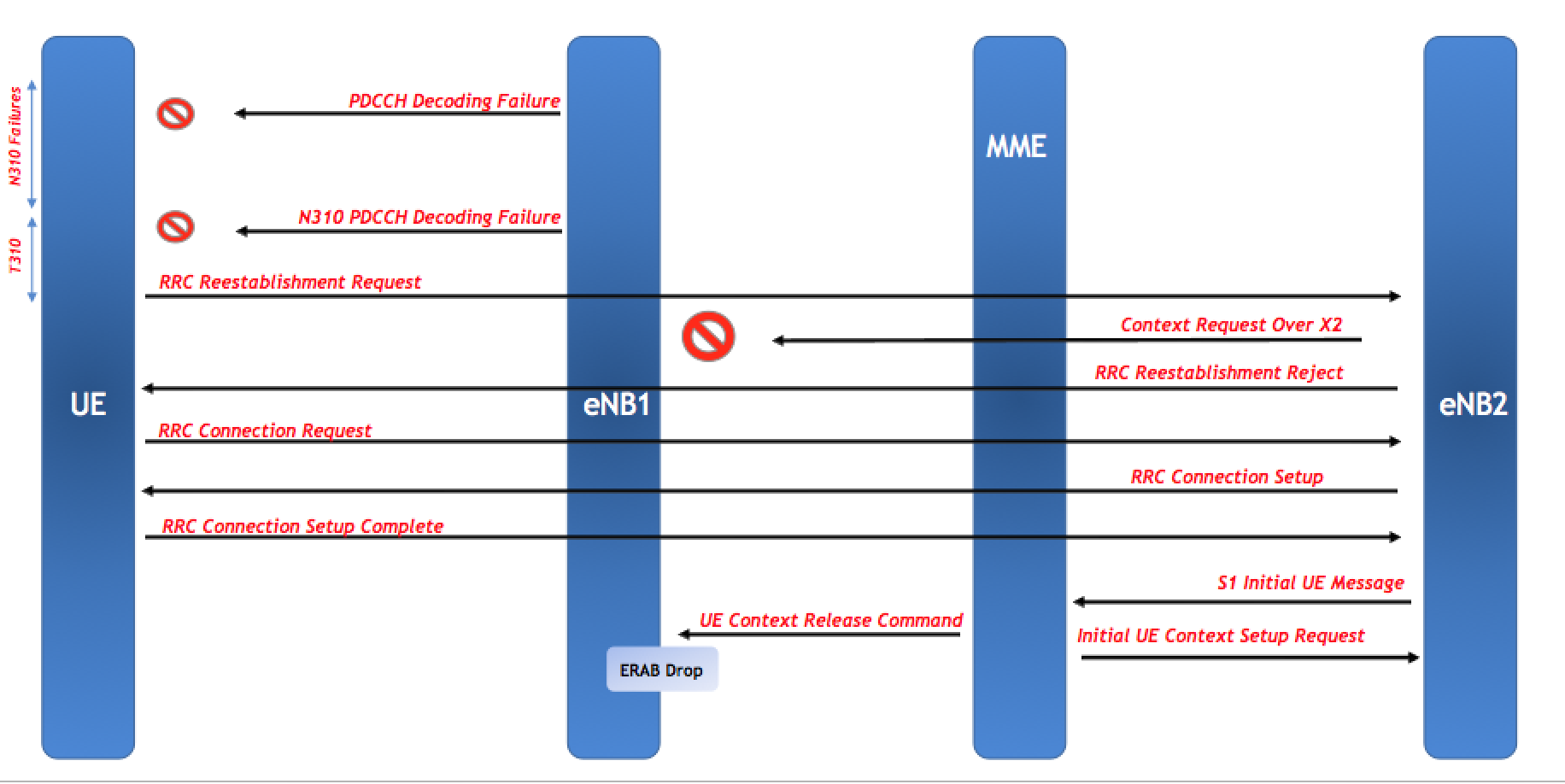
- Optimization
Such issues can be reduced by increasing the N310 & T310 value. For instance, if the value of N310 is increased from 2 to 6 and T310 is increased from 500ms to 1000ms, then the UE will wait longer and there is more chance that N311 will be triggered. N311 is the In-Sync value and so it is the opposite of N310. T310 stops if N311 is triggered. If N311 is 1 then it means that UE needs 100ms of successful PDCCH decoding to stop T310. So, there is a higher probability of triggering N311 if the value of N310 and T310 is big. But the user perception can be impacted so it should be tuned accordingly.
Ø Handover Drop Due To MME
Another drop that is pegged under MME is the handover induced drop. As described before, the HO failure induced drop is pegged under radio due to X2 Reloc Overall Timer expiry. However, if the UE fails the handover then it tries RRC ReEstablishment after T304 expires and if that also fails then the UE will try a new RRC Connection. Once again, the new eNB will send a S1 Initial UE Message to the MME and MME will send a UE Context Release to the source eNB resulting in a Handover Drop due to MME. The main difference between handover failure pegged in radio and MME is the time the UE takes to initiate the new RRC Connection. If the UE initiates a new RRC connection before the source eNB’s X2 Reloc Overall Timer expiry then it will be pegged under MME drop while if the UE is unable to initiate a new RRC Connection in time, the source eNB will release the context due to X2 Reloc Overall Timer expiry resulting in a radio drop.
Moreover, such an issue is usually observed when the UE tries RRC ReEstablishment on a third eNB which was not the target. It can also happen if the Inter-RAT handover fails and the UE retries RRC ReEstablishment on another eNB.
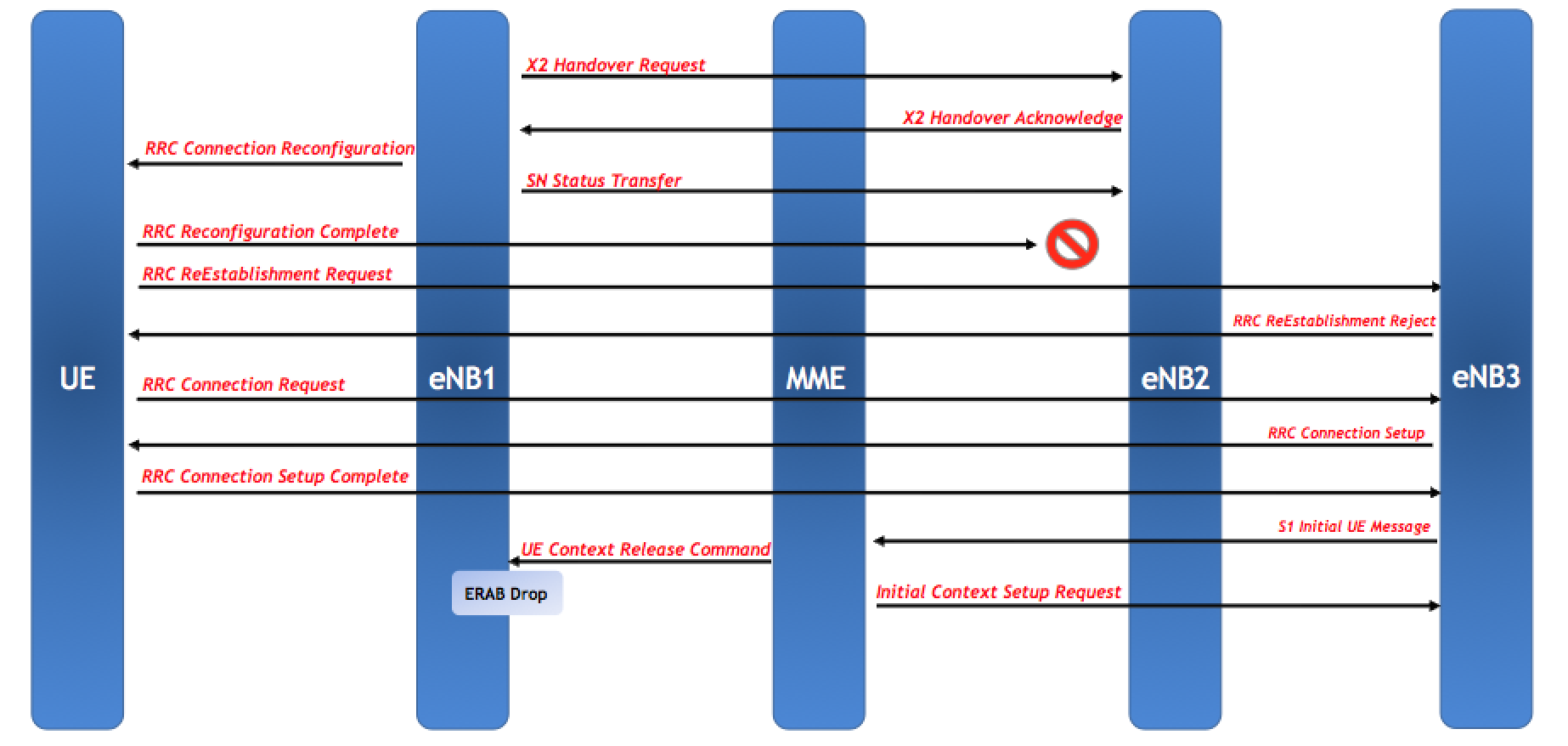
The point to understand is that in this case, the eNB is expecting a UE Context Release from the target eNB over X2. So, if it gets a UE Context Release Command from the MME, the eNB will consider this abnormal and it will peg it under MME drop.
- Optimization
Since the issue is related to handover failure, the specific neighbors should be identified and actions should be taken to resolve the issue with them.
Also, optimization of neighbors and verifying that functional X2 links are present for all the neighbors can greatly reduce the RRC ReEstablishment rejections since most of these rejections are caused due to absence of X2 links. Increasing the timer T301 can also reduce RRC ReEstablishment failures but it can also increase the delay from UE’s perspective, so it should not be increased excessively.
In case of any queries or feedback, please drop a comment below and I would love to respond and help. Also, If you liked this article, then please subscribe to our Youtube channel – Our Technology Planet for more exciting stuff and videos.
Ali Khalid
Latest posts by Ali Khalid (see all)
- 5G Coverage Expansion Analysis – Find The Optimal 5G Coverage Threshold For Your Network - November 9, 2024
- 5G Coverage Expansion - November 9, 2024
- 5G SA Cell Search & Network Entry Matrix - July 18, 2023

Awesome and highly explained, kudos
Hi Ali, Good Noon,
Need your suggestion in understanding how Enb can keep exact record of Voice Drops happening at UE
To elaborate- While we are doing KPI validation, we are seeing high no, of ERAB drops getting pegged in Enb than in DT Tool during Drive test.
UE detect RLF and indicated to Enb. Enb waits for 3 Sec (RLF Timer) and upon expiry of the same, start the process of UE CONTEXT RELEASE with MME and after receiving the response from MME , it increments ERAB drop count, while the call is not actually dropped,
UE will keep on sending Service Request to resume Radio connection post detecting RLF and Enb will act on this request by passing SERVICE request to MME and established Bearers. In this process before the call is actually dropped at UE, Enb will keep on accepting Service Request and increments ERAB drop multiple times and DT toll will increment fewer drops only.
Can u please help me in this
Hello Dharam,
Thank you for your comment.
Please follow the link below and post your question/feedback in Youtube comments section so that Ali Khalid will be able to answer.
LTE Drop Rate – https://youtu.be/8fR5W4tDJjs
Posted, Thanks for your response and guidance on this.
Thanks for a great info but please if you could till more about xontext fetch over X2 not as a concept but if it names with another names as i searched for it at H but unfortinaitlly with no gain so please if more info or hints like switch named ? or it named as another names like?
question for the below
it will try to fetch the context for this UE from eNB1 and based on that it will accept the RRC ReEstablishment.
Hello Walaa,
Please follow the link below and post your question in Youtube comments section and Ali Khalid will be able to answer. Thanks
https://youtu.be/8fR5W4tDJjs
“Some vendors wait for a bit longer (an internal timer)” -is it the T310 timer?
Hi Khallid,
Great explanation.
i’ve a doubt.. As explained above eNB is expecting U Context Release from Target eNB over X2, if it comes from MME then it’ll consider as MME Drop, which is obvious.
But what will happen when there is no X2 link available and so need to go for S1 HO, in this case MME only will send UE Context Release to eNB in all scenario (HO success also and HO Fail as well, after RRC ReEst reject also or New RRC Connection case also) because there is no X2.
So after receiving UE Context Release from MME in all cases, how Source eNB is going to identify whether it is normal release or Abnormal release due cause Radio/MME.
Hi Khallid, great explanation, thank you.
i’ve a doubt.. As explained above eNB is expecting U Context Release from Target eNB over X2, if it comes from MME then it’ll consider as MME Drop, which is obvious.
But what will happen when there is no X2 link available and so need to go for S1 HO, in this case MME only will send UE Context Release to eNB in all scenario (HO success also and HO Fail as well, after RRC ReEst reject also or New RRC Connection case also) because there is no X2.
So after receiving UE Context Release from MME in all cases, how Source eNB is going to identify whether it is normal release or Abnormal release due cause Radio/MME.
“The Call Drop Rate is ratio of total abnormal releases to the total normal releases” .
should be “to the total releases”
Yes you are right 🙂
Hi there
we have high number of abnormal radio failures in our network and all of them are due to UL synchronization Failures, is there any recommendation?
vendor is Huawei, DRX is activated, timealighnment switches are activated too.
I’m a layperson so my knowledge is very limited. I’m trying to figure out how cellular carriers know a call has dropped and how they track it. Is it easy for them to obtain or run drop call data?
From RAN KPIs, it can be found easily if the UE loses connection. CEM can also help in this analysis. There are also many other E2E tools that track call drops.
Perfect. thanks for sharing such a great explanation.
Hi Ali,
I have one question in mind… Why HFN is used in SN transfer during handover why cannot we use SFN.
BR
Partha
HI ALI ;
Hope you are doing well
I have a question regarding the relation between e-Rab abnormal ReL due to DRB and DRX in Huawei .
I noticed that when i opened DRX the ERAB abnormal release due to DRB reset decreased while the ERAB abnormal release due to UL syn failures increased , any clue ?
Thnx
The abnormal releases due to DRB can decrease as DRX increases sleep time which increases the overall time that it will takes to reach the RLC time out threshold.
Hi Ali, I am having HO fail issue between two cells face to face(Good RF conditions)
Better cell handover is triggered as target is better than source
-> HO prep. is successful
-> Source cell prepares UE and releases the radio link
-> But UE does re-establishment back to source due to failed HO (before the HO timer expiry)
-> Better cell HO is triggered again because target RSRP is still better than the source
And this scenario keeps repeating over and over again.Any suggestion to analyze
Thanks a lot Ali,
Well explained.
Much appreciated.
You are welcome, Hassan 🙂
Thanks. Well explained
Thanks
What is the particular cause for the LTE call drop with respect to Modem/UE?
That would be too generic to answer as different handsets can have different signatures e.g. we had a handset causing uplink packet loss and dropping due to it, another having issue at erab establishment, another had a conflict with drx configuration and so on!
Well written Ali, thank you for sharing your expertise on this topic.
Can you please share with us configurations and optimization for NB-IoT stand alone, when time allows.
Also, we will like to know what are all reasons that can be the cause for ERAB release due to unspecify reason by the eNB and any configuration optimization that might help to reduce the number of unspecify ERAB releases.
thanks.
Usually unspecified reason is due to radio issue – generally uplink timeouts or N310.
Thanks Ali..
Dear Ali,
thank you a lot for your help.
according to your experience, do you recommend to activate ANR on LTE network?since there are some articles on internet suggest activation ANR only on early phases.
thank you for your support in advance.
Nowadays, the ANR feature is very mature so it should be enabled for LTE networks. But it is very important that the ANR parameters are correctly optimized for the network.
thank you aloooot dear Ali
very easily Describe its Very Helpful to learner
Thanks 🙂
i have one concern related to ANR in LTE. what is the negative impacts on LTE KPIs in case ANR adding redundant neighboring cells to NRT?
There are scenarios where addition of neighbors that are far away can cause handover failures and drops but most of the ANR algorithms are now tune-able and can be optimized to counter these issues. Such issues were more prevalent around 3 to 4 years ago when ANR functionality was pretty basic.
Khalid Bhai If you can make me understand the functionality of IFLB in Ericsson
Usually, I try to be vendor agnostic but IFLB is pretty much similar across all vendors. You can use offload for LB between different vendors and load-balancing for intra-vendor LB. You can increase subscription capacity to push more load towards higher capacity carriers and you can tune it with a coverage threshold (A5).
Is there any figure of call drop at network level, due to radio reasons (as seen in eNodeB and MME) as against the ones due to core network issues . I do remember it as 70 to 80% due to radio and the rest is because of core network related issues. Any observation on this?
Thanks Ali.
Usually which part will be higher enb or Mme induced drops?
This will depend on the MME Vendor but usually MME drops will be higher.
hi
as you said that in dl rlc transmission some vendors use internal timer
can you explain about that timer
Hi Ali,
Good Job and thanks for sharing.
Useful information Thank you !!
Well explained
Thanks Ankita
Aside doing EURTWP query and Interference detecting monitoring to check if values above neg 114 (-114 dBm average nose power) on Huawei equipment please what again can I use to bring down this high percentage on my KPI?
The first point is to verify if the interference is high because of external or internal source. If it is internal then you can use features like IRC to improve decoding capabilities, CoMP or even SFN can be used to mitigate it. Physical optimization is also a possibility. If it is external then UL FSS and Interference randomization can help.
Hi Ali bhai,
if this thread still open; can you pls share more details about how SFN used to mitigate internal interference.
“Consider a UE that experienced RLF due to maximum number of uplink RLC retransmission. Such a UE will initiate a RRC ReEstablishment procedure to regain its radio link. Now this RRC ReEstablishment can be to the serving cell and in that case, it is usually successful since the serving cell already has the UE’s context. However, this RRC ReEstablishment can also be sent to another cell from eNB2 that does not belong to the source eNB (eNB1). ”
Any theory behind RRC ReEstablishment initiation whether it will be towards the serving cell or another eNB?
Depends on the UE’s coverage at that moment.
Whichever the strongest wrt rsrp
Nothing else?
Won’t the probability triggering rrc Re-establishment request to serving cell high (timer t311starts when UE is still unable to decode pdcch and
It is still camped on serving cell at the time of t310 expiry)
Or is it the other way around since RLF occured meaning serving cell coverage is weak so most likely neighboring cell has better coverage at that specific location so probably is high of initiating Re-establishment to that neighbouring cell
It can go either way. User locations and channels are random so it all goes down to probability.
I discussed this with my senior colleague and as per him there is more to it about this and find more details
Can you provide details
This is what i further found on this
Once the RRC Connection Re-establishment procedure is triggered, the UE shall start the timer T311, and once the UE selects a suitable cell, this T311 timer is stopped, and RRC initiates the transmission of RRC Connection Re-establishment message and start the timer T301. This timer is stopped only when “Reception of RRC Connection Reestablishment or RRC Connection Reestablishment Reject message as well as when the selected cell becomes unsuitable”
If either T311 or T301 expires, the UE goes to idle mode and no more RRC Connection Re-establishments sent. This implies that the UE could try re-establishment only once after the procedure is triggered.
The UE shall select a suitable cell based on idle mode measurements and cell selection criteria.
A “suitable cell” is a cell on which the UE may camp on to obtain normal service. The UE shall have a valid USIM and such a cell shall fulfil all the following requirements.
The cell is part of either:
The selected PLMN, or:
The registered PLMN, or:
PLMN of the Equivalent PLMN list
The cell is not barred
The cell is part of at least one TA that is not part of the list of “forbidden tracking areas for roaming” which belongs to a PLMN that fulfils the first bullet above;
The cell selection criteria are fulfilled
Can you add further into this
Your idea and understanding is correct.
“The most common issue for this kind of failure is when the target cell is very far away such that when the UE initiates handover on the target cell, it is at a distance beyond the cell radius. So, the target cell fails to decode the dedicated RACH properly for this UE and it results in a handover failure. So, in this case, either increase the cell radius of the target cell”
What change increasing the Cell Radius of target Cell actually brings that it starts decoding RACH properly ?
As far as i know number Root Sequences Per Cell will increase with increase in Cell Radius.
Consider that UE is static (for simplification) so what actually happens for the same UE if Cell Radius of Target Cell is increased
Once again, this concept will be covered in a separate topic.
Can you summarize the answer here of my question?
This needs a big description and I will cover it under RACH KPI, once I write about it.
Thanks 🙂
Thanks Ali..
Good articles.
Thanks Jeevan 🙂
Dear Ali,
Can you please start similar thread on VOLTE CSSR and DCR KPis
I will – once I finish the LTE PS part, I will write on the VoLTE KPIs
Hi Ali.
It’s really useful information
i have a question regarding the drop counters, in general i believe that L.E-RAB.AbnormRel Counter incremented by one regardless Reestablishment success or fail but when i cheeked the KPI’s for example i have compered number of HO Failures with L.E-RAB.AbnormRel.HOFailure and the drop due to HO is too low comparing with HO Failures??
Thanks
You should look into the counters for HO failure due to MME, that should show you a more realistic picture.
That’s because is not a rule that one HO Failure will become in one dropped call, maybe the cell have other candidates to make the HO or maybe the UE recovers from the bad signal condition… that depends on the RF environment.
Hi ,
when the ue experience a drop due to MME what is the common drop raison in signaling
Eutran generated raison ???
Thanks
Yeah the most common cause is Eutran Generated Reason.
Hi Ali,
Thanks for good explanations.
I want to ask eutran generated abnormal releases consist mme induced drops which radio and pdcch decoding failure?
Thanks for sharing this valuable document..
You are welcome 🙂
Hello Ali. What kind of RLC retransmission count threshold to increase?
There is 2 of them in Ericsson:
DataRadioBearer ulMaxRetxThreshold
SignalingRadioBearer ulMaxRetxThreshold
Just to increase for Signaling Radio Bearer?Or both?
In downlink, there are counters that can peg if the drop happened due to DRB or SRB and based on that decision can be made. However, in uplink, the eNB is usually not aware whether the issue happened on DRB or SRB, so in case of higher drops, both can be changed.
Thanks
Hi Ali,
if you know the nokia parameter for changing rlc retransmission . thanks
Hi Raheel, I am striving to keep this forum vendor independent so I try not to discuss vendor specific parameters. But you should be able to find it under connection management related documentation.
hi raheel
Did you got the parameter used in Nokia?
Hi Ali, if you know nokia parameter for rlc retransmission
Hello ali,
if you please tell me the Parameter name in nokia for changing ulMaxRetxThreshold. please
Very accurately and simply put.
Very nicely written…thanks for sharing this
Great effort
Thanks Sufyan 🙂
great info. i just want to know the causes of RRC RE-Establishment rejection if RLF triggered HO is enabled suppose all the RRC RE-Establishment should success.
Most common cause, if X2 link is not there or if X2 link is having an alarm.
Hi Ali,
The article is very useful.
Just one query, you have mentioned “N310 indicates an interval of 200 consecutive PDCCH decoding failures”, but I feel it should be 20 consecutive PDCCH decoding failure as 20*10mS=200mS. As we set N310 value as 1,2,3,4,6,8,10,20.
Regards
Somnath
As far as my understanding goes it is 200 ms. If you have a reference on this, kindly do share. It will be worth knowing 🙂
PDCCH exists in each subframe and each subframe is of 1msec …. So 200PDCCH*1msec = 200msec
Really very useful information,
Thanks Raheel 🙂
Excellent article covering all call drop problems in detail.
Thanks 🙂
Excellent article/explaination!
Thanks 🙂
Great explanation
Specially “X2 Reloc Overall Timer” , recently came across this in CHR logs
Thanks for the solution on this issue
Glad that it helped 🙂
Is next topic on Handover?
If yes , can you over ANR as well
Thanks